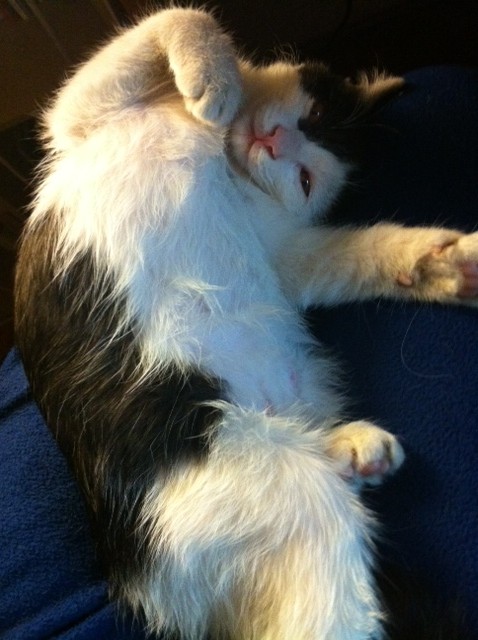
A study to be released this week by the Proceedings of the National Academy of Sciences reports that cats first lived alongside humans as early as 5,300 years ago in the Chinese village of Quanhucun in modern-day Shaanxi province.
One of the study’s co-authors, Fiona Marshall, an archaeology professor at Washington University of St. Louis, said in a Wash U press release: “Results of this study show that the village of Quanhucun was a source of food for the cats 5,300 years ago, and the relationship between humans and cats was commensal, or advantageous for the cats.”
We’ll note, very briefly, that the study was based off work by Chinese researchers at the Chinese Academy of Sciences, who seem to be slowly uncovering evidence that everything in the world originates from China. But we don’t really have a reason to doubt these findings, and indeed that’s not the point of this post. Let’s take a moment to admire cats even more than we already do. After all, those afflicted with Toxo — brain cysts that cats gift us (not to be confused with the carcass of that bird on your doorstep) — are better, stronger, wiser people.
Here’s how the study was done:
Using radiocarbon dating and isotopic analyses of carbon and nitrogen traces in the bones of cats, dogs, deer and other wildlife unearthed near Quanhucan, they demonstrated how a breed of once-wild cats carved a niche for themselves in a society that thrived on the widespread cultivation of the grain millet.
Carbon isotopes indicate that rodents, domestic dogs and pigs from the ancient village were eating millet, but deer were not. Carbon and nitrogen isotopes show that cats were preying on animals that lived on farmed millet, probably rodents. At the same time, an ancient rodent burrow into a storage pit and the rodent-proof design of grain storage pots indicate that farmers had problems with rodents in the grain stores.
Other clues gleaned from the Quanhucun food web suggest the relationship between cats and humans had begun to grow closer. One of the cats was aged, showing that it survived well in the village. Another ate fewer animals and more millet than expected, suggesting that it scavenged human food or was fed.
Researchers are now asking where the first domestic cat came from. Per the Wash U article, DNA evidence suggests “most of the estimated 600 million domestic cats now living around the globe are descendants most directly of the Near Eastern Wildcat, one of the five Felis sylvestris lybica wildcat subspecies still found around the Old World…. ‘We do not yet know whether these cats came to China from the Near East, whether they interbred with Chinese wild-cat species, or even whether cats from China played a previously unsuspected role in domestication,’ Marshall said.”
If you’re looking for the China joke here, don’t bother: Samuel Wade of China Digital Times already has you covered:
The new study does not reveal whether it mattered at this early stage if the cats were black or white.
The name of the cat pictured above is Little One.
Cat domestication traced to Chinese farmers 5,300 years ago (Wash U, via The Atlantic)

















































Seems very unlikely small cats were common in ancient China.
They would surely have been one of the 12 Year Animals if they were common.
Yeah, like dragons
see below.
There are hundreds of stories from ancient China featuring dragons.
Stories with tigers, dogs, pigs, horses, cows, sheep, camels, goats, rats, and hundreds more. Lots of stories with monkeys.
Stories with domestic house cats…. none from ancient China. I haven’t read them all, but I’ve read a bunch.
If you find a story written before 1200 AD, set in China, written by a Chinese, that includes a domesticated house cat, please do let me know.
If you go by the written record, it seems dragons are real, and house cats are mythical.
It seems much more likely that cats were carried into China by Silk Road traders than the idea that they were domesticated in China, and nobody mentioned them in stories.
Well, I dont know any stories like that. Still, these guys provide a pretty solid method suggesting so. PNAS is a pretty solid magazine, doenst just publish anthing.
Thanks to Brendan O’Kane’s brilliant Tumblr, I know cats were a thing in China by at least 1040 A.D.
http://bokane.tumblr.com/post/46306113962/laphamsquarterly-since-i-got-my-cat-five-white
Thanks for posting this.
They may be right.
But archaeologists and other scientists are human, and that means that they are imperfect, and prone to see what they want to see. And sometimes, they lie.
I have an uncle who lived on Kyushu for 32 years, he taught at a university there, and some archaeologists at the school partnered with some more well-known people digging up one of the burial mounds of an old king there on the island.
After more than a year at the site, they closed it up.
Not due to lack of funding.
They gave no reason.
Just closed the dig and left.
And never published anything.
Later, my uncle became convinced the real reason was that they had found evidence that the king was Korean.
Humans are human.
So when did eating cats become hip in the multi-thousands of years of civilization and greatness?